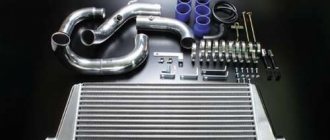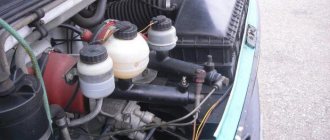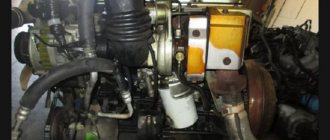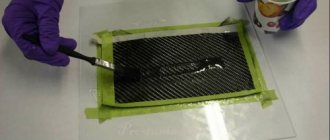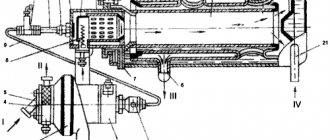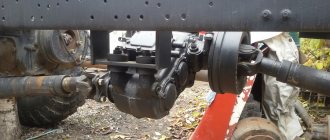Diesel engines are mostly equipped with a turbocharging system. This modification allows you to achieve high engine performance and significantly improve performance characteristics. However, such a modernization of a diesel engine requires a revision of the traditional cooling system.
The fact is that the air pumped into the cylinders significantly increases the engine temperature. And increased heating will inevitably lead to failure of its main components and parts. The design of modern diesel engines equipped with a turbine is devoid of such disadvantages, largely due to the use of a heat exchanger, better known as an “intercooler” or “intercooler”.
Heat exchange must occur correctly
The main purpose of the intercooler is to extract heat from the air flow, which is heated during the compression process in the compressor. That is, the better this heat is removed, the better the heat exchanger works. In order for a turbo system with intercooling to be correctly assembled, it is very important to make the most of the useful properties of the described device. In addition, proper installation of the intercooler will ensure that no problems will arise during the operation of the car. When creating this unit, you need to take into account several criteria, the main ones being the following:
- maximum heat dissipation;
- minimal turbocharging pressure losses;
- increase in air flow inertia.
SQUARE
The difference in the heat exchange area of intercoolers may be a consequence of design nuances. For example, it is reduced by reducing the number of channels and increasing their cross-sections while maintaining the volume of the heat exchanger. This design will result in lower resistance, resulting in lower pressure drop, but reduced cooling efficiency. It is preferable to include such designs in low-pressure systems.
Conversely, the higher the expected boost pressure, the more dense the structure with a high heat exchange area should be selected. If a decrease in the heat exchange area occurs due to a decrease in the volume of the intercooler (less length or number of channels), then this is primarily reflected in the pressure drop due to both an increase in flow rate and a deterioration in cooling. But the turbo lag becomes less noticeable.
How does an air flow cooler work?
The plates and shells in the heat exchanger are responsible for ensuring that heat is removed from the system correctly and in a timely manner. They also make up the area of the heat exchanger, on which the efficiency of the intercooler depends. True, you should not think that if the area is twice as large, then the efficiency of the unit will double. But if you increase the heat exchanger area by ten percent, then the efficiency will increase by exactly the same amount. To understand how an intercooler works, what kind of device it is, it is important to know the features of its design.
So, air passes through it, and if it is difficult for it to do this, then a lot of heat will be lost. On the other hand, it is important to avoid large losses in boost pressure. To compensate for the difficult flow of air through our device, we need to ensure that the internal flow area is large: this will trap air in the intercooler and reduce the air flow. Accordingly, the pressure will be lost at an acceptable level. Thus, when choosing this unit, you should take care of low internal pressure losses.
Intercooler heat exchange area
Heat exchange area is the sum of the areas of plates, fins and tubes in the design of the heat exchanger body, which are responsible for removing temperature from the system. Determining the optimal area can be based on its dependence on the air flow in the turbo system, obtained experimentally and statistically. This is the simplest method, although it provides a fairly large scatter of the desired values; more specific figures are given by calculating the heat exchange area. based on the amount of thermal energy transferred from the charge air to the external air:
- Q=ψStΔTIm or St=Q/ψTIm, where
- Q is the amount of transferred thermal energy;
- ψ—thermal conductivity coefficient;
The numerical characteristic of thermal conductivity of a material is equal to the amount of heat passing through a material 1 foot (ft) thick and 1 square foot (ft2) in area per hour, when the temperature difference between two opposing surfaces is 1 °F. In the chosen system of units, ψ for air is 0.015 VTU/(ft hr°F). The error in the calculation results due to the absence in the thermal conductivity equation of the material from which the heat exchanger is made is critical when designing a new unit. When selecting finished products, it can be neglected;
- St—heat exchange area (ft2);
- ΔTIm is the average temperature difference between the air passing through the heat exchanger outside and inside. In the above formula, however, there is also a value determined from graphs drawn up on the basis of experimental and statistical data. but the spread of results here is less.
- ΔTIm= (ΔT1-ΔT2)F/In(ΔT1/ΔT2), where ΔT1 is the temperature difference between the charge air at the intercooler inlet and the external flow leaving the intercooler:
- ΔТ2 is the temperature difference between the charge air at the outlet of the intercooler and the free flow;
- In(x) is a natural logarithm, the values of which can be determined from Bradis tables;
- F is a correction factor that takes into account the uneven heating of the air passing through the intercooler.
F is determined from the graph (Fig.) based on calculations of two quantities:
- N=(T1-T2)/(T1-Ta1) and R=(Ta2-Ta1)/(T1-T2), where
- T1 — charge air temperature at the intercooler inlet;
- T2 is the temperature of the charge air at the outlet from the intercooler; Ta1 - ambient air temperature in front of the intercooler;
- Ta2 is the temperature of the ambient air passing through the intercooler. In round terms, the heat exchange area can be represented as the sum of the area of the walls of the intercooler channels;
- St=LIxLwxLn, where LI is the length of the channels;
- Lw is the perimeter of the channel cross-section;
- Ln - number of channels.
Based on the experience of manufacturers of heat exchangers for turbo systems. it can be argued that the optimal size of the frontal dimension of the intercooler should be 45% larger than its heat transfer area for the internal flow.
Internal volume is important
The operation of the intercooler will be stable if it is selected correctly. So, the volume inside this device must be completely filled with air, and before pressure builds up in the intake manifold. Volume is one of the parameters that must be optimized when creating a competent intercooling system. This indicator can be calculated as follows:
- the internal volume of the intercooler is divided by the volume of air flow;
- we multiply the resulting amount by two (this number is taken approximately: that is, it turns out that the air flow doubles on the way to acceleration).
When designing an intercooler, it is important to take into account the maximum ability of the system to remove heat from the charge air, so as not to reduce the boost pressure and not prevent the air pressure from increasing.
Audi A4 1.9TDI st3 200 › Logbook › Why do you need an intercooler and the advantages of a front one!
I’ll say right away, the text was copied in some group on VK and saved in a notepad on the phone, I don’t remember what group it was, I copied it for people who asked why I installed a front camera, etc., but I decided to throw it here just to throw some sul, well. maybe someone else is interested... If there are authors of this text, I will gladly add a link to the original source or delete the entry... Japanese or German, even if we are in the auto industry, the intercooler has one task in any case!
All Japanese turbo cars are equipped with intercoolers (air coolers) from the factory, but they are usually located either under the hood or in the fender, that is, they are not frontal (located in the front bumper of the car for better airflow). The exceptions, perhaps, are the GTR and Evo. Toyota has a worse situation with this. In this article we will try to highlight the pros and cons of installing a front mount intercooler (FMIC).
It is no secret that a turbine compresses air, creating pressure and thereby heating it to a certain extent, depending on atmospheric pressure, air temperature, etc. The hotter the temperature outside, the more your turbo heats the air entering the intake manifold. The more the air heats up, the less its density and the presence of oxygen molecules, the less gasoline enters the mixture, the less power.
Standard under-hood or “winged” intercoolers have a relatively small area and are poorly ventilated, especially under the hood, since, among other things, they are also heated by the engine. This is all exacerbated during the hot summer months - prime time for racing. Therefore, if the car is used for driving, racing and minimizing power losses is vital, then installing a front intercooler becomes a necessity.
Intercoolers are selected for a specific power rating that matches your vehicle. But, as a rule, it is better to do this with a reserve of 100-200 hp. This does not affect the lag in any way, but you will certainly be able to avoid unnecessary losses. For example, on a car 300 hp. It makes sense to install an intercooler suitable for up to 500 hp. etc. Pipes and pipes are usually selected to correspond to the diameter of the throttle valve of the intake manifold or the inlet of the intake manifold if there are several throttle valves. The connection diagram should ideally be such that the length of the pipes is as short as possible. The diameter of the pipes should thicken as they move away from the turbine, and the inlet to the intercooler should preferably be equal to the diameter of the throttle valve, as well as the outlet accordingly.
It is highly desirable that the pipes running under the hood in areas of potential heating (from turbines or the engine) are insulated with heat-non-conducting materials.
The intercooler itself is best placed in the front bumper in front of the air conditioning radiator or the main engine radiator. It is often necessary to trim the bumper so that as much of the intercooler area as possible is blown by the oncoming air flow. It is also advisable to install a fine mesh in front of the intercooler to prevent it from being damaged by stones and other objects that often fall into the car on our “beautiful” roads.
A properly installed front intercooler will immediately affect the power of your car. The density of the air will increase, the amount of oxygen in it will increase, the mixture will become richer and the power will accordingly increase. On different cars and configurations, the percentage of increase is different, but even on a standard Supra, for example, you can expect at least 30 hp, or even 50. If the car is being boosted, then a front-mounted intercooler is a must-have item
Power and efficiency are the main indicators
The cooling system in a car must work smoothly. To do this, you need to know how much power is lost when intercooler pressure is lost. We compare the absolute pressure indicator with and without the device. It is also worth remembering that it is not at all necessary to restore lost power, since in this case the pressure in the exhaust manifold will become higher, which will lead to an increase in the reversal of exhaust gases into the combustion chamber and an increase in the temperature in it.
To calculate the efficiency of the intercooler, it is necessary to compare the increase in air temperature, which is caused by the operation of the turbine, and the decrease in temperature, which is caused by the cooler. Today you can buy two types of this device: “air-to-air” or “air-to-water”. The first option is a simpler design, but it is also characterized by higher efficiency at high speed. In addition, it has higher reliability, and it is much easier to maintain such a device. An air-to-water intercooler shows good efficiency at low speed, but has a complex design and is more expensive. But at the same time, the air-to-air intercooler pipe is more difficult to install, the unit needs more space, so such a device is not suitable for every car.
What is an intercooler in a car?
It should be noted that the intercooler can be designed horizontally or vertically. Which one is better to use, as well as which intercooler radiator to install on the car, depends on the location in the engine compartment. A device operating on the air-to-air principle is large in size, and high demands are placed on its installation location.
In addition, it must be taken into account that such products are critical to the condition of the cooling surface. If it is dirty, there is local damage, then the efficiency of the entire device is reduced.
The best option is considered to be when such products are installed in front of the cooling radiator. It should be noted that an error in choosing the installation location can lead to disruption of the entire operation of the intercooler. The main principle of operation will not be fulfilled - instead of releasing temperature, the air may heat up due to its high value in the engine compartment, as a result of which the diesel engine will only work worse.
Therefore, an intercooler that uses water is much more convenient. In addition to the fact that it requires less space for installation, the use of water increases its efficiency several times. However, such a device requires the use of additional elements to operate.
A simple technical solution, which is based on the principle of forced cooling of compressed air supplied to the diesel engine, allows you to increase engine power by providing conditions for optimal fuel combustion. An additional benefit will be improved environmental performance of the engine.
What else is worth reading
How does turbocharging work?
Headlight washer device
Diesel engine cooling system
Flushing the engine cooling system
Dmrv
Balanced intercooler: what is it?
For a cooler to be optimally balanced, it is important that it meets certain requirements:
1. The internal flow area must be good. It is the cross-section of the heat exchanger core that affects how much pressure will be lost during the passage of air. It is almost impossible to calculate the correct cross section, but you can at least predict what it should be. For example, you can use turbulators that prevent air from pressing against the walls of the unit and transferring thermal energy to it. Both improved heat transfer and low flow losses depend on the density of turbulators.
2. The size of the core plays an important role. The shorter the channels through which air passes, the lower the flow area will be.
3. The frontal area, reflecting the amount of ambient air, helps to cool the inflated air. Accordingly, the greater the mass of the surrounding air, the higher the cooling capacity of the intercooler will be.
4. Streamlining of the core shape. The free movement of air throughout the device depends on this parameter, and the lighter the air, the greater its volume will pass through the intercooler (there is no doubt that this will directly affect the cooling effect).
5. The characteristics of the cooler can be improved by using channels that will supply cooling air. Experts believe that by using a good channel, it is possible to increase the efficiency of the heat exchanger by approximately 20%.
6. The amount and speed of air flow also depend on the size and shape of the pipe.
7. The stability of the intercooler is influenced by such indicators as bends and transitions of sections, as well as the presence of pipes. By the way, any bend in the system is a potential loss of flow. And if the pipes are not tightly connected, then the boost pressure will be lost.
Intercooler Heat Transfer
With today's development of technology, the method of manufacturing a heat exchanger primarily affects its price, service life and maintainability, while the main indicators that determine the effective reduction in the temperature of the inflatable air are the dimensions of the intercooler. More precisely, its heat transfer area.
With extremely small assumptions, it can be argued that the heat exchange area for internal and external air flows is the same. Its required value can be determined based on the amount of heat transferred from hot air to cold air, the equation describing heat transfer for each internal flow (either internal or external). looks like that:
- Q=GmCpΔT. where Q is the amount of thermal energy transferred (BTU, 1 BTU=1.0550559 kJ);
- Gm—mass air flow (Ib/min);
- Cp is the heat capacity of the medium, equal to 0.25 for air;
- ΔT is the difference in air temperature at the inlet to the outlet of the heat exchanger (°F).
When calculating external flow parameters, it is necessary to take into account that the air leaving the intercooler in the direction of the engine compartment is heated unevenly. The part that blows on the side closest to the turbine is hotter, and the side closest to the throttle is colder, and the equation includes the arithmetic average of these temperatures. The relationship between volumetric and mass air flow rates is described by the ideal gas equation:
- Gm=P Gv/RT or Gv=Gm RT/P, where
- Gm—mass air flow (Ib/min);
- Gv - volumetric air flow (cf/min);
- P - absolute pressure (∼14.7 psi) for the environment);
- R=0.37 is the gas constant for these dimensions:
- T is the temperature in degrees Rankine (°R). Т(°R)=460+Т(°F).
Since most companies producing products for turbo systems present the characteristics of their products in the system of units used by the USA and Great Britain, then. as in the calculations when selecting a turbocharger, converting everything to the metric system does not make sense.
To calculate the thermal energy released by inflatable air, all parameters are known. Based on the level of expected power, when selecting the characteristics of the turbocharger, the flow rates, pressures and temperatures in the intake manifold necessary to obtain it were determined.
The temperature at the outlet of the turbocharger was also determined using the formula:
- T1 = Ta1+Ta1(-1+P, 0.263)/Ec, where T1 is the temperature at the compressor outlet (°R);
- Ta1-ambient temperature (°R);
- Pr is the degree of pressure increase;
- Ec is the compressor efficiency.
Where is the intercooler radiator located?
Usually this unit is located in a free space where there is a lot of space. The main thing is not to install it in the engine compartment or behind the cooling radiator, since the boost pressure will be low and the air will not warm up. In such cases, the cooler acts as a kind of intermediate heater. It is worth remembering that the intercooler heating up from the heat under the hood can lead to serious problems. Therefore, it is necessary to insulate this unit and carefully place all pipes. Typically, an air-type intercooler is installed in a free location, such as behind the front bumper in the center, above the engine under the hood, or on the side of the fenders (on either side).
What is a diesel intercooler: principle of operation and causes of device failure
Diesel engines are mostly equipped with a turbocharging system. This modification allows you to achieve high engine performance and significantly improve performance characteristics. However, such a modernization of a diesel engine requires a revision of the traditional cooling system.
The fact is that the air pumped into the cylinders significantly increases the engine temperature. And increased heating will inevitably lead to failure of its main components and parts. The design of modern diesel engines equipped with a turbine is devoid of such disadvantages, largely due to the use of a heat exchanger, better known as an “intercooler” or “intercooler”.
Why does a car need an intercooler?
Almost any modern diesel engine is equipped with an intercooler. Despite all the different varieties of such devices, their main purpose remains the same - lowering the temperature of the discharge air. Typically, the intercooler is installed directly after the turbine. The air passing through the tubes of the presented device gives off most of the heat and, being cooled, enters the combustion chamber of the engine.
The cooled air mixture has greater density. This consistency is most optimal from the point of view of efficient operation of any engine. The greater the density of the air mixture, the greater the volume of air entering the combustion chamber. This mixture will promote higher pressure inside the cylinders, which will significantly increase the efficiency of the diesel engine.
The design of the intercooler itself is made in such a way that the air passing through it does not encounter any obstacles on its way. Otherwise, this would entail a decrease in the pressure pumped into the air turbine, which would adversely affect the efficient operation of the engine.
The fundamental location of the heat exchanger may vary, depending on the characteristics of the engine compartment of a particular vehicle. In most cases, it is mounted in front of the main radiator of the cooling system, or in the side part near the wing.
The useful area of the cooling elements of the heat exchanger is calculated individually for each individual type of diesel engine, taking into account its technical characteristics and operating conditions.
Each car has its own intercooler
Today it is very common to create a cooler for a specific engine. For example, the Nissan intercooler is suitable for each model of this brand differently. Therefore, when choosing a cooler, you need to take into account many details: the frontal area of the heat exchanger and its thickness, flow direction, internal flow area and much more. At the same time, new Nissan cars are equipped with “clean” engines, which do not have an intercooler or turbocharging.
The Mercedes intercooler is a heat exchanger that reduces the temperature of the air passing through it. In most models of this brand, the heat exchanger is located in the front part of the engine compartment and is blown naturally while the vehicle is moving.
Intercooler, what is it for?
Increasing the power of an internal combustion engine is solved quite simply - it is necessary to ensure optimal conditions for fuel combustion in the engine cylinders. However, such a task seems simple only at first glance. To supply additional oxygen to the engine, a special device is used - a turbine, which compresses atmospheric air, and in this form it enters the internal combustion engine. Most often, diesel engines are equipped with such products.
Due to the fact that atmospheric air is compressed, its density increases, which will ensure that more oxygen enters the engine. However, according to the laws of physics, when gas is compressed, the temperature increases, and supplying hot air to a diesel engine is one of the possible options for its rapid destruction. Therefore, a device such as an intercooler is used to reduce the temperature of the compressed air.
Why do you need an intercooler?
What is this, many will ask - another bells and whistles for the car or a really necessary thing? And is it worth installing? Most experts agree that it is necessary for turbocharged engines. In addition, today you can choose a variety of configurations of this device, which, however, in no way affect the efficiency of its operation. That is, any aesthetic delights, say, some original shape or design of intercooler receivers, play a more decorative role than a functional one.
Experts also advise choosing units made of thin sheet metal, as it will promote maximum heat retention. The type of intercooler should be selected depending on the specific features of the existing turbine.
Intercooler intake tract diameter size
With an increase in the speed of inflatable air in the inlet and outlet pipes of the intake system, the resistance to its movement also increases, and resonant processes develop. With excessively large diameters, the inertia of the turbo system increases dramatically. as they add volume to the overall system. There is a certain speed optimum, equal to approximately 0.25-0.28 of the speed of sound, or 450 ft/sec, at which negative phenomena do not exceed a critical level. Based on these values, the appropriate intake tract diameter can now be calculated.
- s=π(d/2)2=ηA/VB, where
- VB - flow velocity in the intake tract (275-308 ft/sec);
- Po - air flow passing through the motor at maximum power mode cf/min);
- s is the cross-sectional area of the exhaust pipeline (in2);
- d - pipeline diameter (in)
- η — reduction coefficient equal to 2.4 (min/sec)/(ft2/in2).
